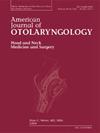Comparison of tympanostomy tube insertion with and without radiofrequency ablation eustachian tuboplasty for treating chronic otitis media with effusion
IF 1.7
4区 医学
Q2 OTORHINOLARYNGOLOGY
引用次数: 0
Abstract
Objective
The objective of this study was to compare the effect and complication of tympanostomy tube insertion (TTI) alone and radiofrequency ablation (RFA) tuboplasty combined with TTI for the treatment of chronic otitis media with effusion (COME) with chronic eustachian tube dysfunction (CETD) in adult.
Material and methods
The patients with COME and CETD who met the inclusion criteria were allocated to TTI alone group and TTI + RFA tuboplasty group. Primary outcomes were tube retention success and total ETDQ-7score. Secondary outcomes were TT premature extrusion, recurrence, hearing improvement, perforation closure, and complications.
Results
The Tube retention success rates were 78.6 % in the TTI alone group and 95.2 % in the TTI + RFA group (P < 0.05). Postoperative 6 months total ETDQ-7 score was significantly reduced in the TTI alone group and TTI + RFA group, whereas the total score in the TTI + RFA group was significantly lower than that in the TTI alone group (P < 0.05). The TT premature extrusion rates were 21.4 % in the TTI alone group and 4.7 % in the TTI + RFA group (P < 0.05). The OME recurrence rates in the TTI alone was significantly higher than that in the TTI + RFA group (21.4 % vs 2.4 %, P < 0.05). Postoperative ET inflammation scale or IT hypertrophy grading significantly decreased in TTI + RFA groups (P < 0.001), whereas scale in the TTI alone group had no significant change (P = 0.065). The complete aeration of the middle ear and mastoid rates in the TTI + RFA group was significantly higher than that in the TTI alone group after a followup period of 12 months (P = 0.040). Stenosis/scar of anterior-post wall in the ET orifice was seen in 3 patients in the TTI + RFA group.
Conclusions
TTI combined with RFA tuboplasty is effective and safe for COME in adult. Compared with simple TTI, application of RFA tuboplasty can effectively improve the tube retention and reduce the OME recurrence.
鼓室造瘘管置入与不置入射频消融咽鼓管成形术治疗积液性慢性中耳炎的比较
目的比较单纯鼓膜造瘘置管(TTI)与射频消融术(RFA)管成形术联合TTI治疗成人慢性中耳炎伴积液(COME)合并慢性咽鼓管功能障碍(CETD)的疗效及并发症。材料与方法将符合入选标准的COME和CETD患者分为TTI单独成形术组和TTI + RFA成形术组。主要结果为试管保留成功和总etdq -7评分。次要结果是TT过早挤压、复发、听力改善、穿孔闭合和并发症。结果TTI组输卵管留置成功率为78.6%,TTI + RFA组为95.2% (P <;0.05)。TTI组和TTI + RFA组术后6个月总ETDQ-7评分显著降低,TTI + RFA组总评分显著低于TTI组(P <;0.05)。TTI单独组的TT过早挤压率为21.4%,TTI + RFA组为4.7% (P <;0.05)。单纯TTI组OME复发率明显高于TTI + RFA组(21.4% vs 2.4%, P <;0.05)。TTI + RFA组术后ET炎症评分或IT肥厚分级均显著降低(P <;0.001),而单纯TTI组的量表无显著变化(P = 0.065)。随访12个月后,TTI + RFA组中耳全通气率和乳突通气率显著高于单纯TTI组(P = 0.040)。TTI + RFA组3例患者出现ET口前柱壁狭窄/瘢痕。结论stti联合RFA成形术治疗成人COME有效、安全。与单纯TTI相比,应用RFA成形术可有效改善管潴留,减少OME复发。
本文章由计算机程序翻译,如有差异,请以英文原文为准。
求助全文
约1分钟内获得全文
求助全文
来源期刊

American Journal of Otolaryngology
医学-耳鼻喉科学
CiteScore
4.40
自引率
4.00%
发文量
378
审稿时长
41 days
期刊介绍:
Be fully informed about developments in otology, neurotology, audiology, rhinology, allergy, laryngology, speech science, bronchoesophagology, facial plastic surgery, and head and neck surgery. Featured sections include original contributions, grand rounds, current reviews, case reports and socioeconomics.
 求助内容:
求助内容: 应助结果提醒方式:
应助结果提醒方式:


